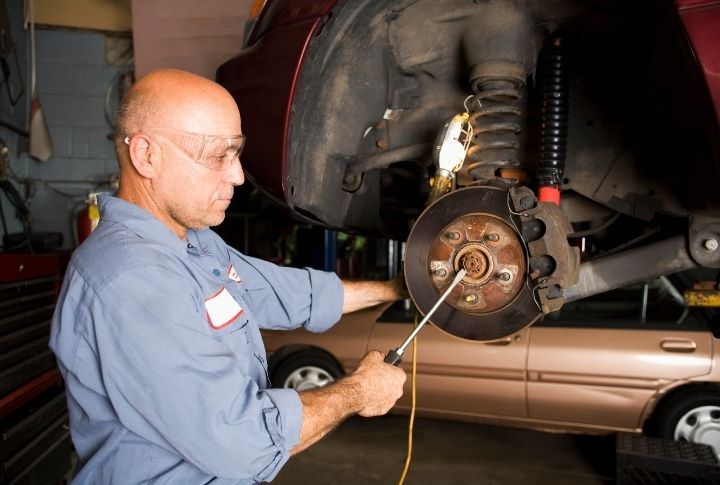
15 Common Mistakes to Avoid When Changing Your Brake Pads

Thinking about tackling a brake pad replacement on your own? It’s a great way to save money and gain some mechanical know-how, but it’s easy to slip up if you’re not careful. According to the FMCSA, brake-related violations ranked 8 out of 20 top vehicle violations in 2020. The NHTSA also reported that faulty brakes caused 22% of all collisions in 2015. To help you steer clear of common errors, we’ve compiled a list of 15 mistakes people often make when changing their brake pads.
Neglecting Safety Precautions

One of the most common mistakes is not prioritizing safety. Always wear protective gear, such as gloves and safety glasses, use jack stands to securely support the car, and work in a well-ventilated area to avoid inhaling brake dust and fumes.
Using Incorrect Tools

It’s essential to have the correct wrenches, sockets, and specific brake tools, such as a C-clamp or brake caliper tool. Investing in quality brake pad tool kits ensures you have what you need to avoid damage to the brake components for a smoother task.
Not Cleaning the Brake Components

Dirt and debris interfere with the installation and function of new brake pads. Always clean the brake calipers, rotors, and surrounding areas with brake cleaner before installing new pads. Clean brake parts help the new pads to sit properly against clean surfaces, enhance braking, and extend the lifespan of the brake parts.
Failing to Compress the Caliper Piston Well

The new brake pads won’t fit correctly if the caliper piston isn’t fully compressed. Loose pads will lead to uneven wear and poor braking performance. Use a C-clamp or a brake caliper tool to push the piston back into the caliper housing.
Overlooking the Brake Fluid Level

When compressing the caliper pistons, the brake fluid level in the reservoir can rise. Failing to check and adjust the brake fluid level can lead to overflow and potential damage to the brake unit. Continuously monitor and adjust the fluid level accordingly, and if necessary, remove some brake fluid to prevent spillage.
Forgetting to Apply Brake Lubricant

Proper lubrication of the brake pad backing and caliper pins prevents noise and allows smooth operation. Apply a high-temperature brake lubricant to these areas to maintain optimal braking. Appropriate lubrication eliminates squeaking, and brake pads can move freely within the caliper.
Ignoring the Rotor Condition

When you install new brake pads on worn or damaged rotors, you will reduce the efficiency of your brakes and pad life. Inspect the rotors for wear, grooves, and thickness. Have them resurfaced or replaced if necessary so the new brake pads have a smooth, even surface to press against.
Incorrectly Reassembling Components

Misplacing or improperly assembling the brake components brings about serious issues. You must follow the manufacturer’s instructions carefully and reassemble all elements securely. Double-check that all bolts and clips are in place and that the brake pads are seated correctly within the caliper.
Not Bedding in the New Pads

Bedding in or breaking in new brake pads helps them seat well against the rotors. However, skipping this step reduces braking efficiency and pad lifespan, so follow the specific bedding-in procedure recommended by the brake pad manufacturer.
Overtightening or Under-tightening Bolts

Always apply the correct torque to bolts and fasteners. Overtightening can strip threads or damage elements, while under-tightening can lead to loose parts. A torque wrench allows you to screw the bolts to the manufacturer’s specifications and guarantee that everything is secured well.
Neglecting to Check the Brake Lines

Damaged or worn brake lines can compromise the brake system’s integrity. Inspect the brake lines for wear, cracks, or leaks and replace them for safety and reliable braking. Remember to do this carefully to avoid tampering with the unit’s overall health.
Disregarding Manufacturer Specifications

Each vehicle has specific requirements for brake pads and components. Ignoring the manufacturer’s specifications can lead to improper fitment and performance issues. Use the recommended parts at all times and stick to the steps in the owner’s manual for compatibility and optimal results.
Not Testing the Brakes Properly

After changing the brake pads, you must test the brakes even in high-speed scenarios. Check for proper brake pedal feel and response and ensure no unusual noises or vibrations. Run a test drive in a safe area to verify everything is working fine, and make any necessary adjustments before resuming regular driving.
Skipping Routine Maintenance

Periodically check the brake pads, rotors, and fluid levels to catch any issues early and ensure the brakes remain in good working condition. Regular maintenance guards against unexpected brake failures and extends the system’s life.
Rushing the Job

A rushed job is a recipe for more issues later on due to mistakes and sloppiness. Allocate enough time to perform the brake pad change methodically and carefully to complete each step correctly. Paying attention to detail ensures optimal safety and performance and helps you avoid costly repairs.


